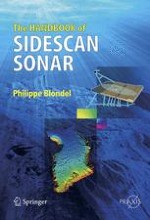
2009 | OriginalPaper | Buchkapitel
Conclusion
verfasst von : Dr Philippe Blondel, C.Geol., F.G.S., Ph.D., M.Sc.
Erschienen in: The Handbook of Sidescan Sonar
Verlag: Springer Berlin Heidelberg
The Earth is a small planet, and modern communication tools remind us every minute of this simple fact. Browsing through Google Earth or one of its Internet equivalents, we can zoom in on any point in the world, and gather all the information we want about it. But the oceans are still largely hidden from view. We know more about other planets, or asteroids passing in the sky, than we know about the underwater domains just a few kilometers away. Yet, learning about our planet, monitoring its health and its evolution, managing its resources in as sustainable a way as possible cannot happen unless we know what is happening under water. And for this, the only tool is acoustics. Animals developed and have used sonar for a long time: dolphins can detect and identify objects from a few centimeters to a few hundreds of meters in very opaque waters; whales can communicate from one side of the ocean to the other. But we have only just begun to master the construction and use of sonars. Along with the development of computer-aided techniques for processing the signals and interpreting the images, these technologies have greatly advanced our knowledge of the deep seas.